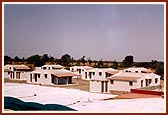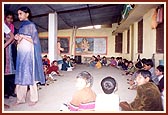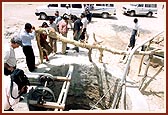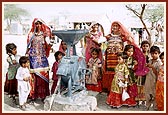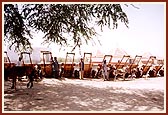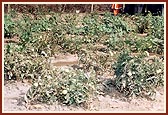|
|
Since the tragic earthquake
in Gujarat in January 2001, BAPS has been active in providing relief
for the victims. After the emergency relief work, permanent rehabilitation
projects were undertaken by BAPS.
With the help of donors of
all faiths from India and abroad, BAPS has been able to reconstruct
13 villages and 43 schools.
In addition to this, a separate
project funded by donations from Canada-based donors - BAPS Swaminarayan
Sanstha (Canada), Sanatan Mandir, Hindu Mandir and CIDA (Canadian International
Development Agency) has been completed by the BAPS Swaminarayan Sanstha,
Gujarat Earthquake Relief Project team in India.The major objectives
of this project were as follows:
- To build homes
- To build schools
- To build social facilities
- To provide a means of livelihood for
farmers and women
- To build primary health care facilities
- To cultivate kitchen gardens
After signing the formal project
undertaking on 21 January 2002, the required work was completed by BAPS
Swaminarayan Sanstha by 31 March 2003, as follows:
1. Homes
- Canada Hill Colony, Bhuj Housing Colony
(62 homes)
- Toronto Colony, Bhuj Housing Colony
(44 homes)
- Sanatanpuram, Morjhar, sub-dist. Nakhatrana
(100 homes)
- Ramnagar, Dadhar, sub-dist. Khavda
(23 bhunga homes)
- Canada Village, Bhirandiyara, sub-dist.
Khavda (83 bhunga homes)
- Narsinh Mehta Nagar, Bhirandiyara,
sub-dist. Khavda (76 bhunga homes)
2. Primary Schools
- A.P.J. Abdul Kalam Primary School,
Anjar (120 boys & 80 girls)
- Sant Mansoor Primary School, Soyala
(25 boys & 10 girls)
- Terry Fox Adarsh Primary School, Pragpar-II
(32 boys & 21 girls)
- Pramukh Swami Primary School, Morjhar
(58 boys & 42 girls)
3. Public Utilities
- Canada Hill Colony, Bhuj (Water Tank,
Community Hall, Women's Training Center, Administrative Office)
- Sanatanpuram, Morjhar (Water Tank,
Community Hall, Women's Training Center, Administrative Office)
- Ramnagar, Daddhar (Women's Training
Center)
4. Facilities for Women to
Earn Livelihood
- Handlooms (Bhirandiyara, Hodko, Misriyado,
Pragpar-II, Nani Bhujpar, Siracha)
- Mixer machines (Baraiya, Pragpar-I,
Pragpar-II, Sama Goga)
- Masonry kits (Morjhar, Siracha, Bhirandiyara)
- Sewing machines (Bhirandiyara, Hodko,
Misariyado, Pragpar-I)
- Sewing kits (Bhirandiyara, Hodko,
Misariyado, Ramnagar)
- Spice-grinding machines (Madhapar
- Canada Hill Colony)
- Loudspeaker systems (Madhapar - Canada
Hill Colony)
- Mandap Cleaning equipment (Madhapar
- Canada Hill Colony, Bhirandiyara)
- Flour grinding machines (Bhirandiyara
[Harijanvas], Bhirandiyara [Kolivas], Soyla, Gandhinu Gam, Kukma)
- Wood kit (Bhirandiyara [Kolivas],
Gandhinu Gam, Siracha, Misariyado)
- Woodwork machine (Gandhinu Gam, Meghpar
[Navovas], Misariyado, Bhirandiyara [Kolivas])
- Pushcarts (Bhirandiyara [Kolivas],
Bhirandiyara [Harijanvas], Ramnagar)
- Wooden cabins (Bhirandiyara [Kolivas],
Bhirandiyara [Harijanvas], Ramnagar, Gandhinu Gam)
- Tile polishing machines (Pragpar-II)
- Equipment for making khakra, papad,
etc. (Bhuj - Tin Tent City)
5. Facilities for Farming
and Cattle-rearing
- 6.5 acres of grass grown
- Fruit trees planted
- Distribution of 154 buffaloes (with
3 years insurance and veterinary care arrangements)
- Drinking water and lake for buffaloes
- Rickshaw for transporting milk and
grass
6. Mobile Dispensaries
Two mobile dispensaries serve
48 remote villages, providing primary healthcare and treatment and health
awareness education.
7. Kitchen Gardens and Tree
Planting
- 412 homes with Israeli drip irrigated
kitchen gardens enabling daily requirement of vegetables.
- Kitchen gardens in 21 primary schools
in Mandvi district, enabling vegetables for mid-day meals for children.
8. Training Programs
- Gender Equity Training
- Gender Orientation Training
- Result Based Management ( RBM) Training
- Workshops on appropriate construction
technology
- Livelihood Development Study Tour
- Workshop on Medicare and Health Promotion
The special features of this
project include:
- Traditional lifestyles have been
preserved. Cooperation from the beneficiaries at every stage.
- 85% of beneficiaries are of unscheduled
castes and tribes, 5% are of backward class and 10% are of other
classes.
- People are able to live without having
to move and can earn their livelihood as before.
- Raw materials from local suppliers,
providing economic boost to the region.
- Employment for beneficiaries in the
reconstruction process as per their abilities.
- Homes designed and built as per requirements
of beneficiaries, especially women.
- Joint ownership of home by husband
and wife.
- Long-term employment opportunities
as per local traditions for both men and women.
- Awareness of need for financial independence
through special training.
- Health awareness and health care by
doctors.
- Kitchen gardens, maintained with drip
irrigation systems, to provide fresh, healthy source of vegetables.
- Reconstruction of primary schools.
- Encouragement of handicrafts and home
industries as a means of livelihood.
- Women's forums established.
- Long-term needs of beneficiaries catered
for.
|



